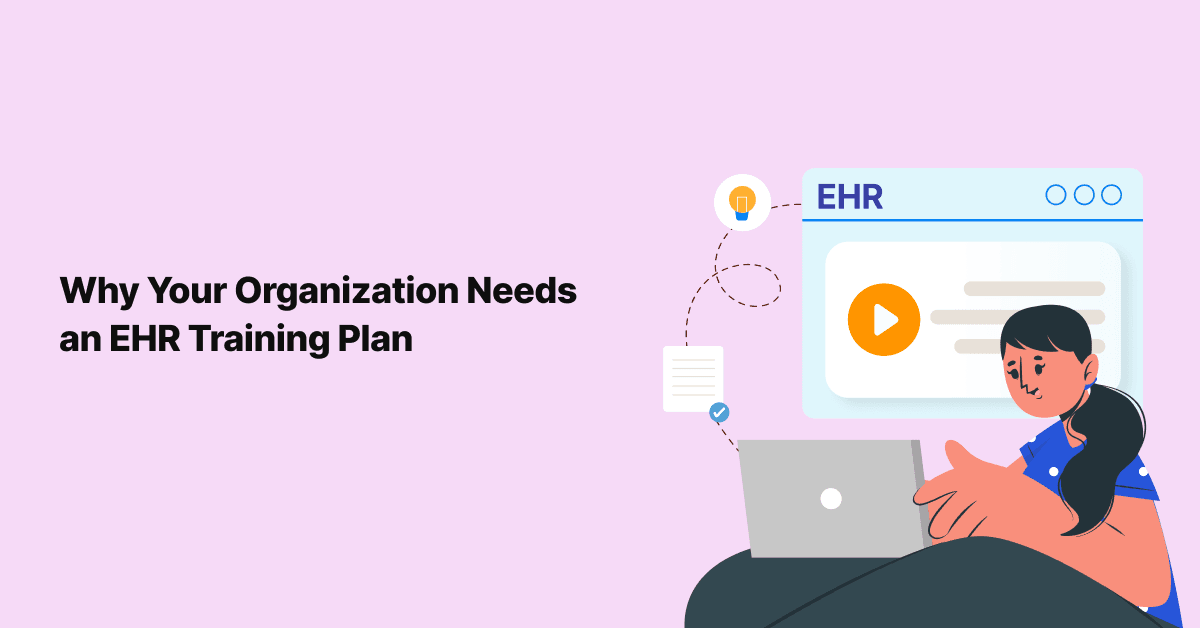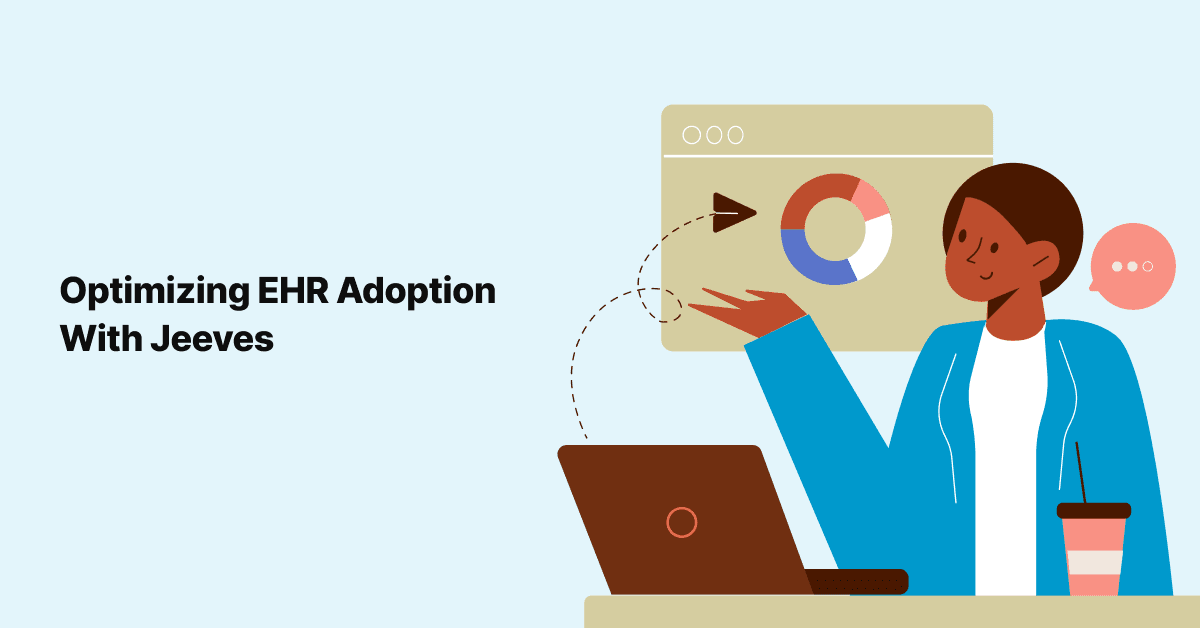
Your Guide to Reducing Support Tickets With Jeeves
The need for software support in healthcare is inevitable, especially with the transition to EMRs. Service …

In today’s digital age, the healthcare industry has undergone a significant transformation with the widespread adoption of Electronic Health Record (EHR) systems. These systems have revolutionized the way healthcare organizations manage patient data, streamline operations, and improve patient care. However, the successful implementation and utilization of EHRs hinge on one critical element: a well-structured EHR training plan. And this blog, goes into the details of why your healthcare organization needs an EHR training plan.
What this blog covers:
Before delving into the reasons your organization needs an EHR training plan, let’s first clarify what EHR training entails. EHR training is a systematic process that equips healthcare professionals and staff with the knowledge and skills needed to effectively use Electronic Health Record systems. It encompasses various aspects, including:
Before diving into the details of an EHR training plan, it’s essential to understand the challenges that healthcare organizations often face during EHR implementation:
Healthcare professionals may resist adopting new technologies, viewing them as disruptive or time-consuming. An EHR training plan should address these concerns and provide incentives for embracing the change.
Not all healthcare staff members are tech-savvy. Some may struggle with the technical aspects of EHR systems. Training should be tailored to different skill levels, ensuring everyone can use the system effectively.
Integrating EHR systems into existing healthcare workflows can be challenging. Training should show staff how EHRs can complement their daily tasks and make their jobs easier.
Now, let’s explore why your organization should prioritize the development and implementation of an EHR training plan.
Effective EHR training directly impacts the quality of patient care and an EHR training plan is the starting point of providing impactful training. When healthcare professionals are well-versed in using EHR systems, they can access patient information quickly and accurately. This enables them to make informed decisions, reduce errors, and provide better care. Timely access to critical information, such as allergies, medical histories, and medications, can be a matter of life and death in some cases.
The healthcare industry is highly regulated, with strict data privacy laws such as HIPAA (Health Insurance Portability and Accountability Act) in the United States. An EHR training plan ensures that your organization’s staff is aware of and compliant with these regulations. This reduces the risk of non-compliance penalties, legal issues, and breaches of patient confidentiality.
Patient data is one of the most valuable assets in healthcare. Inadequate EHR training can lead to privacy breaches and violations. A well-structured training plan educates staff on security best practices, such as password management, access control, and recognizing phishing attempts. It helps create a culture of data security within your organization.
EHR systems are engineered to streamline healthcare processes, but their efficiency relies heavily on the proficiency of users. An effective EHR training plan ensures that your staff members can navigate the system with ease, significantly reducing the time dedicated to administrative tasks. This, in turn, translates into more valuable hours dedicated to patient care, a noticeable improvement in workflow efficiency, and the potential for substantial cost savings.
While investing in an EHR training plan may initially appear as an additional expense, it is a strategic investment that can yield substantial long-term cost savings. By minimizing errors, reducing compliance violations, and enhancing overall efficiency, your organization stands to reap significant financial benefits. Furthermore, the avoidance of expensive data breaches and legal fines becomes an invaluable safeguard for your bottom line.
Every healthcare organization is unique, with its own workflows and priorities. An EHR training plan allows you to tailor the training to your organization’s specific needs. You can focus on the features that are most relevant to your staff and patients, ensuring that the training is both effective and efficient.
A well-planned EHR training plan includes mechanisms for measuring its effectiveness. Key Performance Indicators (KPIs) can be tracked to assess staff proficiency, system utilization, and patient outcomes. This data enables you to make informed decisions and continually improve the training program.
It is key to remember that an EHR training plan holds value not only during implementation but even after that. Read more about Maximizing the Value of Your EHR Training Plan: Beyond Go-live here.
Now that we understand the importance of an EHR training plan, let’s explore the key components that should be included:
Begin by assessing the specific training needs of your organization. Identify the roles and responsibilities of each user group and tailor the training program to their unique requirements.
Develop a curriculum that covers essential EHR functions, including data entry, patient chart navigation, order entry, and compliance training. Consider offering both initial training for new staff and ongoing training to keep existing staff up to date.
Choose appropriate delivery methods for training, which may include in-person workshops, online courses, webinars, or a combination of these. The training format should align with the preferences of your staff.
Hands-on practice is crucial for reinforcing learning. Ensure that users have opportunities to practice using the EHR system under supervision and receive feedback.
Implement assessments and certification processes to gauge the effectiveness of the training. Certification can provide a sense of accomplishment and motivation for staff to engage fully in the training.
Collect feedback from trainees to identify areas for improvement in the training program. Use this feedback to continually refine and enhance the training plan.
In conclusion, an EHR training plan is not just nice to have but a critical component of successful EHR implementation in healthcare organizations. It improves patient care and safety, ensures compliance with regulations, enhances data security, increases efficiency, and can lead to significant cost savings.
Remember that EHR training is an ongoing process. As technology evolves and healthcare practices change, your organization must keep its staff updated and proficient. Prioritizing EHR training demonstrates a commitment to providing the best possible care to patients while safeguarding their sensitive health information.
Investing in an EHR training plan is an investment in the future of your organization’s success and the well-being of the patients you serve.
Join over 3,200 subscribers and keep up-to-date with the latest innovations & best practices in Healthcare IT.

The need for software support in healthcare is inevitable, especially with the transition to EMRs. Service …

Over the past few years, the healthcare industry has seen a lot of development in terms of technology. …

As a CIO, if you had to get your clinicians’ feedback on the newest EHR implemented or the most recent upgrade …